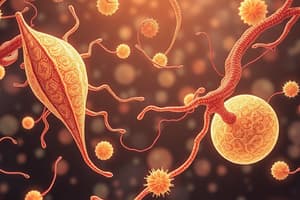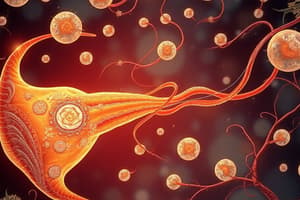Podcast
Questions and Answers
What is the ploidy level of primary spermatocytes?
What is the ploidy level of primary spermatocytes?
- Triploid (3n)
- Tetraploid (4n)
- Diploid (2n) (correct)
- Haploid (n)
How many chromosomes does a secondary spermatocyte have?
How many chromosomes does a secondary spermatocyte have?
- 69 chromosomes
- 23 chromosomes (correct)
- 92 chromosomes
- 46 chromosomes
Which process occurs after the DNA of a primary spermatocyte replicates?
Which process occurs after the DNA of a primary spermatocyte replicates?
- Meiosis I (correct)
- Cytokinesis II
- Meiosis II
- Mitosis
What developmental change do spermatogonia undergo to become primary spermatocytes?
What developmental change do spermatogonia undergo to become primary spermatocytes?
How many cells are produced from one primary spermatocyte undergoing meiosis I?
How many cells are produced from one primary spermatocyte undergoing meiosis I?
Flashcards are hidden until you start studying
Study Notes
Spermatogenesis
- Spermatogonia that lose contact with the basement membrane undergo developmental changes and differentiate into primary spermatocytes after crossing the blood-testis barrier
- Primary spermatocytes are diploid, having 46 chromosomes
- Primary spermatocytes replicate their DNA and initiate meiosis I
- Meiosis I results in the formation of two secondary spermatocytes
- Each secondary spermatocyte has 23 chromosomes, the haploid number (n)
Studying That Suits You
Use AI to generate personalized quizzes and flashcards to suit your learning preferences.



